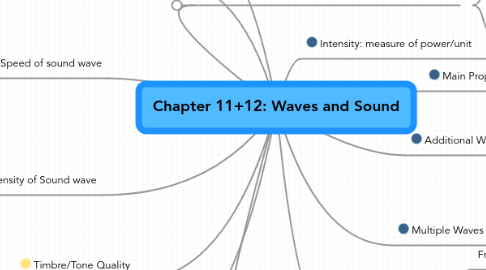Chapter 11+12: Waves and Sound
by Rebecca Harman


1. Wave: disturbance that travels away from its source
1.1. Transverse (S)
1.1.1. Perpendicular
1.1.2. Ex: Seismic
1.2. Longitudinal (P)
1.2.1. Parallel
1.2.2. Ex: Seismic, sound
2. Standing Wave
2.1. One wave is reflected and interferes with incident wave
2.2. Anti-Node: halfway in between nodes
2.3. Node:Halfway between points of max. amplitude
2.4. Fundamental Frequency: lowest freq. standing wave
3. Sound Wave
3.1. Uniform distribution of molecules is disturbed
4. Frequencies of sound wave
4.1. Audible range: 20Hz-20kHz
4.2. Infrasound: below 20Hz
4.3. Ultrasound: abover 20kHz
4.4. audible range varies with animals
5. Speed of sound wave
5.1. Square root of Frequency/linear mass density
5.2. Increases .606m/s per each degree C increase
5.3. Speed of sound at room temp (293K): 343 m/s
5.4. Intertia: characterized by mas density
5.5. Speed of sound at 273K: 331 m/s
6. Amplitude + Intensity of Sound wave
6.1. Pressure Amplitude
6.1.1. Pressure fluctuation above/below pressure in absense of wave
6.2. Displacement Amplitude
6.2.1. mas. displacement of an element of medium from equilibrium
6.3. Intensity is proportional to amplitude squared
6.4. Threshold of hearing:reference intensity with intensity level
6.4.1. 1E-12 W/m2
6.5. Intensity increase of a factor of 10; 10dB added
6.6. Intensity Unit: decibels
7. Standing sound waves
7.1. Pipe closed at one end
7.1.1. Wavelength: 4L/n
7.1.2. Closed end: pressure antinode + displacement node
7.2. Pipe open at both ends
7.2.1. Same boundary condition at each end
7.2.2. Wavelength:2L/n
7.2.3. Open ends: pressure nodes + displacement antinodes
8. Timbre/Tone Quality
8.1. Harmonics:fundamental and overtones
8.2. Overtone: frequencies that are not the fundamental
9. Intensity: measure of power/unit
9.1. decreases as the distance from source increases
10. Periodic Wave
10.1. Frequency: Occurence of pattern repeating
10.1.1. Inverse of period
10.2. Repeats the same pattern
10.3. Period: time is takes for one wave
10.4. Amplitude: height of wave
10.5. Wavelength:distance of wave travel
11. Additional Wave Properties
11.1. Reflection of waves: ave with an abrupt boundary between mediums
11.2. Refraction: Change in propagation direction
11.3. Compression: waves are bunched
11.4. Rarefaction: Waves are spread
12. Multiple Waves
12.1. Interference
12.1.1. Destructive: waves 180 degrees out of phase
12.1.2. Constructive: waves in phase of eachother
